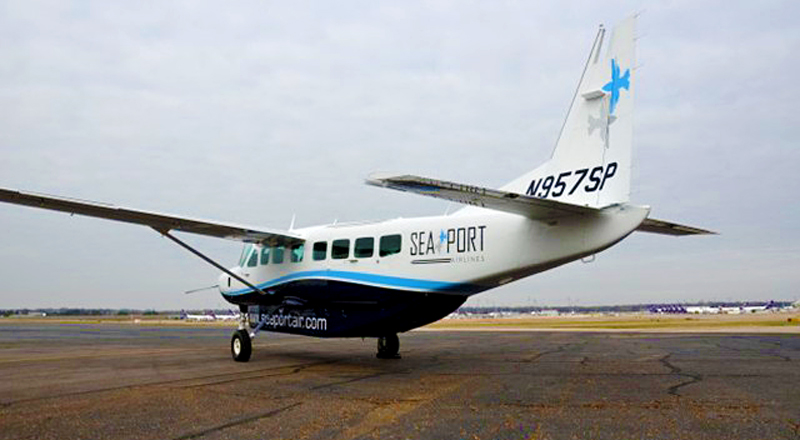T he struggling upstart airline out of Portland tried to provide hometown service with worldwide connections for eight years, but it simply did not make it, as SeaPort Airlines, Incorporated posted an official announcement at its Internet Web Site which revealed the bad news:
Portland, Oregon-based SeaPort Airlines, Inc. announced that it is ceasing all operations at the close of business on September 20, 2016. The airline made a motion today to convert is bankruptcy proceedings from Chapter 11 to Chapter 7 of the U.S. bankruptcy code. Tim Sieber, president of SeaPort Airlines, said, “This is a very sad day for our employees, shareholders, and the communities we serve. I would like extend my heartfelt appreciation to the employee team that I have been honored to lead and who delivered industry leading operational performance. While we made great strides, a successful financial reorganization did appear possible and we were forced to make the difficult decision to cease operations.” Customers with tickets on SeaPort Airlines that were purchased with MasterCard or VISA credit cards may apply for a refund through their credit card company. Customers using other credit cards must inquire at their respective credit card companies about refunds.
Customers posted comments in reaction to the news at the official Facebook Internet web site of the airline.
The Downfall of SeaPort Airlines
Not even the lowest fuel prices in years prevented the company from declaring bankruptcy protection due to a shortage of pilots nationwide, as SeaPort Airlines, Incorporated filed a voluntary petition for Chapter 11 reorganization back in February of 2016 in the United States Bankruptcy Court for the District of Oregon.
Additionally, Timothy Sieber — who was executive vice president of SeaPort Airlines — had been promoted to president of the company, replacing Rob McKinney, who had resigned as president and chief executive officer.
A shortage of pilots was also cited as a factor towards the demise of the airline, as it has forced similar smaller airlines to cancel flights and ground airplanes as a “side effect” of regulations by the federal government of the United States which have dramatically increased the minimum number of flight hours required for new pilots.
Air Travel Alternative: Advantages to You
“…the United States of America has not suddenly disbanded the Transportation Security Administration, or TSA,” I wrote in this article on Wednesday, June 2, 2010 pertaining to SeaPort Airlines, which at that time was operating for almost two years since its official launch in June of 2008 with a route between Portland and Seattle, “but there is at least one airline on which one can fly within the United States without having to pass through airport security. Imagine not having to wait in long lines, take your shoes off, or be detained for a secondary screening — and you may also enjoy the benefit of reduced flight delays while you are free to carry your drink on-board the aircraft.”
Possible advantages to flying as a passenger on airlines such as SeaPort Airlines typically include:
- Not having to pass through a security checkpoint — meaning that you can arrive later for your flight and board the airplane within mere minutes
- Travel between smaller airports, which could mean greater flexibility of routes, free parking, and flights which have a better chance of departing and arriving on time
- More flight options if the airline is flexible with its flight schedule
- The airports may be located closer to your origination or final destination
- Fewer people means a more “private” experience
Air Travel Alternative: Disadvantages to You
Possible disadvantages to flying as a passenger on airlines such as SeaPort Airlines typically include:
- Smaller airports could mean fewer services available — such as rental car facilities and restaurants
- The airports could be located farther from your origination or final destination
- Long-haul flights are generally not possible
- Increased chances of cancelled or delayed flights due to inclement weather, as smaller airplanes are used
- Fewer flight options if the airline is not flexible with its flight schedule
- Cost — especially when a special deal is not available — which includes fees such as for wait time
Summary
At this time, I am not sure of the state of the financial health of the airlines and companies — which are included in this incomplete list compiled last year and on which I have yet to be a passenger — with similar concepts to SeaPort Airlines…
…and sadly, that might not matter — especially with one fewer airline pertaining to the ceasing of operations of SeaPort Airlines.
Until viable new disruptive technology — such as possibly traveling from London to New York in one hour or traveling from New York to London in eleven minutes — becomes a reality to provide true competition to current options in commercial aviation, the idea of air services such as SeaPort Airlines seem to offer a viable alternative for travelers despite their limited networks of flights to smaller airports at select destinations.
It would be a shame to have this business model as a hassle-free alternative eventually fail overall — and the ceasing of operations of SeaPort Airlines sadly seems to portend that possibility, as more choices and options available to customers are usually beneficial.
Source: SeaPort Airlines, Incorporated.

